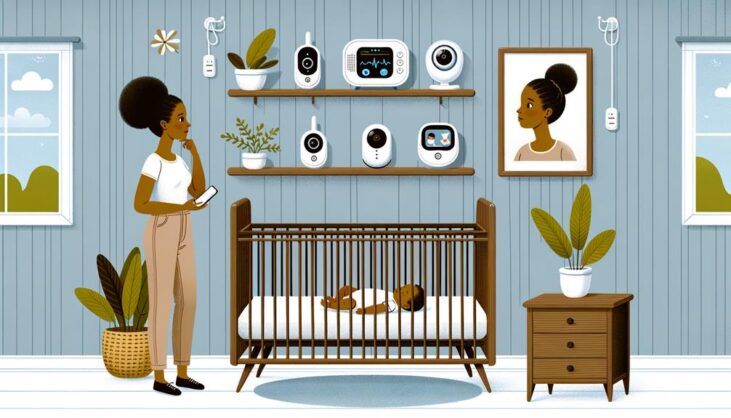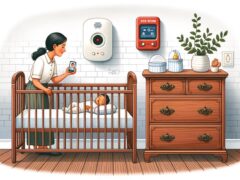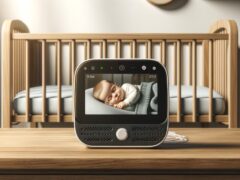
How to Choose the Right Baby Monitor
When selecting the ideal baby monitors, first decide if you prefer audio-only, video, or Wi-Fi-enabled models. Audio-only monitors are simple and focus solely on sounds, while video monitors allow you to see and hear your baby. Wi-Fi-enabled monitors offer the convenience of checking on your baby from anywhere through your smartphone.
It’s important to think about privacy and security. Non-Wi-Fi monitors are generally more secure from hacking risks, providing peace of mind. However, Wi-Fi monitors offer the advantage of easy remote access, which is great for parents who might need to monitor their baby while away from home.
Look for features that enhance the monitor’s effectiveness and your convenience. High-quality night vision is essential for clear images in low light. Reliable connectivity, whether through closed-circuit or Wi-Fi, ensures you’re always connected to your baby. Long battery life is crucial for uninterrupted monitoring.
Consider additional features that may be helpful. Temperature sensors help you ensure the baby’s room stays at a comfortable temperature. Some monitors also include lullabies that can help soothe your baby back to sleep.
Choosing the right baby monitor involves balancing these features to find what best meets your family’s needs. This decision can significantly enhance your ability to care for your baby with confidence and ease.
Key Takeaways
- First, figure out what type of baby monitor fits your needs: audio-only for simple listening, video for visual monitoring, or a Wi-Fi-enabled smart monitor for high-tech connectivity.
- Next, think about privacy and security. If you want extra security, a closed-circuit monitor is a solid choice. For the convenience of checking on your baby from anywhere, a Wi-Fi monitor might be the best option.
- Then, look into the specific features of the monitors. Some come with night vision, which can be helpful for seeing your baby in the dark, temperature sensors to ensure the room is comfortable, and even lullabies to help soothe your baby to sleep.
- It’s also important to check the connectivity and range of the monitor. Make sure it can cover the distance needed in your home, considering any walls or barriers that might interfere.
- Lastly, consider the battery life and portability of the monitor. A durable, long-lasting battery and easy-to-carry design are crucial for consistent, reliable monitoring.
By choosing carefully, you can find a baby monitor that not only keeps you informed but also fits seamlessly into your lifestyle, ensuring your baby’s safety and your peace of mind.
Understanding Baby Monitor Types
In the world of baby monitors, you have a few choices, each with its own special features tailored to different needs. Audio baby monitors are basic but effective, focusing on transmitting sounds from your baby’s room. They’re ideal for parents who want a simple way to hear if their baby is crying or making any noise. On the flip side, video baby monitors offer a visual perspective, featuring high-quality cameras and night vision. These are great for parents who want to see and hear their baby.
Baby monitors that connect to Wi-Fi can be accessed from anywhere you have an internet connection. This feature is handy for parents who need to monitor their child while away from home. However, it’s crucial to consider the security risks when your baby’s images and sounds are transmitted over the internet. In contrast, non-Wi-Fi baby monitors provide a more secure, privacy-conscious choice since they don’t send data through the internet and work well for parents who stay mostly at home and prioritize privacy.
Selecting the right baby monitor—whether it’s an audio-only version, a video-equipped model, one with Wi-Fi connectivity, or one without—depends on what you value most, from simple sound monitoring to real-time visual monitoring from any location. Each type offers different levels of privacy and security, important factors to consider to ensure both your baby’s safety and your own peace of mind.
Key Features to Consider
When selecting a baby monitor, focus on essential features that boost safety and enhance connectivity. Night vision is crucial for maintaining clear visibility in low-light conditions, ensuring you can always see your baby clearly. Examine the different connectivity options; some parents might prefer the security of a closed-circuit system, while others might value the convenience of a Wi-Fi-enabled device that allows for monitoring from anywhere.
Historically, baby monitors have evolved from simple audio-only systems to sophisticated devices offering video streaming, health monitoring, and mobile notifications. This evolution mirrors the exploratory spirit in improving child safety technology, constantly pushing the boundaries of what these devices can do to provide peace of mind to parents.
Connectivity Options
When choosing a baby monitor, think about the different ways it can connect. This helps to make sure it fits your privacy and security needs. Here are some important points to consider:
- Closed-Circuit Systems: These monitors offer unmatched privacy since they don’t connect to the internet, cutting out any chance of hacking.
- Wi-Fi Capabilities: This feature lets you watch over your baby using your smartphone, no matter where you are. However, it’s wise to remember this type of monitor can be less secure.
- Dedicated Parent Unit: Perfect for keeping an eye on more than one child without draining your smartphone’s battery. It’s a practical choice for busy parents.
- Combination Units: These monitors provide both a dedicated parent unit and a smartphone app. This dual approach allows for flexible and versatile monitoring.
Choosing the right baby monitor involves understanding the balance between convenience and security. Each type of monitor offers a different blend of both, allowing you to explore the best option suited to your family’s needs.
Always consider how these technologies have evolved to enhance user experience while prioritizing child safety.
Night Vision Capabilities
Ensure your baby monitor features top-notch night vision to clearly see your child in dim conditions. Choose monitors with a premium camera that provides Full HD 1080p resolution. This clarity is vital for overseeing your baby’s safety and comfort during the night.
Such high resolution offers detailed views of your baby’s activities while they sleep peacefully, undisturbed. A robust night vision capability is crucial—it allows you to watch over your child effectively, ensuring they’re safe and sound.
It’s important to confirm that the night vision adapts well to different light levels in your baby’s room.
Evaluating Connection Options
When choosing a baby monitor, you need to weigh the options between closed-circuit and Wi-Fi systems, each offering distinct security features. Let’s explore these differences:
Firstly, consider the security and privacy aspect. Closed-circuit monitors are more secure as they send data directly to a dedicated parent unit without connecting to the internet. This setup significantly lowers the risk of your personal data being exposed.
On the other hand, Wi-Fi monitors allow you to check on your baby from anywhere using the internet. However, this convenience also makes them more susceptible to hacking. Their reliance on internet connections exposes them to greater security vulnerabilities.
Now, let’s talk about the type of transmission. Closed-circuit monitors operate on a localized system, which is inherently safer from external breaches. In contrast, Wi-Fi monitors transmit data over the internet, potentially through less secure networks, increasing the risk of unauthorized access.
Lastly, think about how crucial data security is for you. If safeguarding your privacy is a top priority, you might lean towards a closed-circuit monitor. Although it limits remote monitoring capabilities, it offers superior protection against data breaches.
Monitoring Through Apps
Closed-circuit and Wi-Fi baby monitors offer differing levels of security, but app-connected monitors revolutionize how you monitor your baby from afar. These smart monitors, linked to apps, dramatically improve your connection with your child, providing unparalleled flexibility and convenience. You can monitor your baby directly from your smartphone or tablet, ensuring you remain connected regardless of your location.
These advanced devices support remote viewing, enabling you to check on your baby without entering the nursery and potentially disturbing their sleep. Functions such as two-way talk allow you to calm your baby with your voice, providing comfort even when you’re not present. Features like temperature monitoring and customizable settings ensure the nursery environment is secure and cozy for your baby.
You will also receive instant notifications and alerts on your device, keeping you updated on any changes or needs your baby may have. This ongoing connection offers reassurance and meets the needs of your hectic schedule, making the well-being and safety of your baby a constant priority.
These monitors represent a significant leap in parenting technology, merging traditional monitoring with modern innovation to enhance the care and safety of your child.
Battery Life and Portability
When choosing a baby monitor, the battery life is crucial as it determines how long you can use the device without needing a recharge. Selecting a model with strong battery life improves your monitoring experience, keeping you connected when it’s essential. Be aware that battery performance can differ significantly, so evaluate your requirements and be cautious of claims that may seem too good to be true.
Here are important factors for managing battery life and enhancing portability:
- Adjust Sensitivity and Quality Settings: Customize the sensitivity and quality settings to find a balance between effective monitoring and battery conservation. Higher settings usually use more power.
- Monitor Usage Patterns: Think about how often and for how long you use the monitor. If you need it frequently for long periods, choose a model built for sustained use.
- Keep Parent Units Charged: To ensure ongoing monitoring, keep parent units plugged in whenever possible. This strategy increases reliability without using up the battery.
- Evaluate Advertised Battery Life: Check the battery life claimed in advertisements against real-world reviews and how you plan to use the monitor to ensure it meets your needs during crucial moments.
Safety and Security Tips
Ensure your baby’s safety by maintaining a distance of at least 3 feet between the crib and any monitor cords. This precaution prevents the risk of strangulation. Always secure these cords well beyond your child’s reach. Additionally, avoid installing the monitor directly on the crib rails to prevent any accidents should the monitor fall.
When choosing baby monitors, be wary of those that claim to monitor breathing or movements, as their reliability can be questionable. For accurate health monitoring, consulting a pediatrician is advisable to determine the best options for your baby’s specific needs.
For users of smartphone-connected baby monitors, enhancing security is crucial. Utilize strong encryption and unique passwords to protect your video feed from unauthorized views. This step is essential to preserve your family’s privacy and to ensure your baby’s moments remain private.
Each of these strategies not only enhances safety but also encourages a journey of vigilant, informed parenting. Exploring these practices helps navigate the complexities of modern parenting effectively.
Frequently Asked Questions
How to Decide What Baby Monitor to Get?
When choosing a baby monitor, several key factors should be considered to ensure safety and efficiency. First, examine the monitor range. A good monitor should cover the entire area where your baby will spend time, whether it’s a small apartment or a larger house. Next, look at the battery life of the unit. Long-lasting batteries provide peace of mind that the monitor won’t die in the middle of the night.
Another important feature is night vision. This allows parents to see their baby clearly in low light conditions, making it easier to check on the baby without disturbing their sleep. Additionally, consider monitors that offer two-way audio. This feature lets you speak to your baby from another room, which can be soothing for both the baby and the parent.
Also, some monitors provide information on the room temperature, which helps ensure that your baby is comfortable. Monitors that can play lullabies may also be beneficial, as they can help lull your baby to sleep.
When it comes to choosing the right monitor, think about its portability and durability. A portable monitor can be easily moved around the house, while a durable one will withstand the occasional drop or bump. The type of connectivity—whether Wi-Fi or a direct connection—also impacts the monitor’s performance and the ease of setup.
Finally, app compatibility is crucial if you want to monitor your baby through your smartphone or tablet. This feature allows for a more flexible monitoring system.
How Much Should You Spend on a Baby Monitor?
When setting a budget for a baby monitor, prioritize essential features. Look into the dependability of the product, compare its features, and check warranty details to ensure it fulfills your caregiving requirements effectively.
Selecting a baby monitor isn’t just about price; it’s about finding a reliable tool that helps you ensure your baby’s safety. By choosing a model that is celebrated for its durability and user-friendly design, you can explore the world of parenting with more confidence and less worry.
Do Pediatricians Recommend Baby Monitors?
Indeed, pediatricians often suggest using baby monitors as a tool to increase your infant’s safety, enhance sleep quality, and alleviate your stress. These devices are valuable for monitoring your child’s health, delivering crystal-clear audio, and ensuring reliable nighttime surveillance.
Baby monitors are equipped with features that cater to the vigilant parent. The high-definition audio and video capabilities allow you to watch over your baby with exceptional clarity, making it easier to detect any unusual signs or sounds. This vigilant oversight can be especially comforting when you are in another part of the house or sleeping at night.
Moreover, many baby monitors now come with advanced functionalities such as temperature sensors, motion detectors, and even options for tracking sleep patterns. These features not only keep you informed about the immediate environment of your child’s nursery but also help in understanding and responding to your baby’s needs more effectively.
In essence, the use of baby monitors represents a proactive approach to parenting, giving you a technological advantage in ensuring the wellbeing of your baby while providing peace of mind.
What Is the Difference Between a Baby Monitor and a Baby Camera?
A baby monitor typically captures sounds which helps parents listen to their infant from another room. Adding a baby camera enhances monitoring by providing visual footage, remarkable night vision, and sensitive motion alerts. Features common to both devices include two-way communication, Wi-Fi connectivity for remote access via apps, and robust encryption security ensuring privacy and safety.
Historically, the evolution of baby monitors reflects a significant leap from simple audio monitors to sophisticated video surveillance systems. Initially, baby monitors served the primary purpose of audio surveillance, alerting parents to their baby’s cries or sounds. Over time, technological advancements have integrated video capabilities, allowing parents not just to hear but also to see their child from a distance. This development has greatly improved the ability of parents to monitor their child’s safety and well-being remotely.
Each advancement in baby monitor technology offers parents improved tools to explore and connect with their child’s environment, even when they are not physically present. This exploration is rooted in the desire to ensure the ultimate safety and comfort for their children, showcasing a blend of care with technological exploration.
Conclusion
When selecting the ideal baby monitor, focus on practicality and tranquility. Key factors to consider include the type of monitor, its connectivity options, and essential features. It’s crucial to opt for models that include app integration, allowing for continuous oversight from your devices. Also, a long-lasting battery is vital for convenient mobility. Safety and security must lead your decision-making, ensuring your monitor choice effectively safeguards your infant.
Historically, the evolution of baby monitors reflects significant technological advances. Initially simple audio devices, modern monitors now incorporate video, movement detection, and internet connectivity, providing comprehensive surveillance capabilities. This progression supports the notion that high-quality, advanced monitors are paramount in monitoring your child’s safety effectively.
By adhering to these guidelines, you ensure a wise and informed selection, safeguarding your baby’s well-being while maintaining your peace of mind. Trust in the refined technology to diligently watch over your precious child.
- Top 3 Baby Monitors for New Parents
- Avoiding Common Mistakes When Setting Up Your New Baby Monitor
- Exploring the Benefits of Multi-Camera Baby Monitors for Larger Homes
- Monitoring Your Baby’s Sleep: Essential Tips for Using Baby Monitors Effectively
- Safety Tips for Using Baby Monitors
- The Role of Smart Technology in Baby Monitors: Benefits and Concerns
- The Latest Advances in Baby Monitor Technology













